skip to main |
skip to sidebar
 Welcome to the golden hour of film! The age old tradition of film photography has always possessed an inherent warmth and beauty, that transcends technical explanation. As photographers, we relish something called "The Golden Hour" (sometimes known as magic hour) which is the first and last hour of sunlight during the day, because the quality of light is such that everything becomes magically photogenic. Due to the diffusion of the sun's abundance of light, and the hues created by the atmosphere, everything is illuminated within photographic reach. Well, Kodak's new Portra400 has this magical quality packed right into the emulsion! No matter the lighting situation, Kodak's Vision Technology brings it within reach. Pretty much anything your eye can see now is visible within one frame. We have always loved film for this quality, but the limits have been stretched further than formerly possible.
Welcome to the golden hour of film! The age old tradition of film photography has always possessed an inherent warmth and beauty, that transcends technical explanation. As photographers, we relish something called "The Golden Hour" (sometimes known as magic hour) which is the first and last hour of sunlight during the day, because the quality of light is such that everything becomes magically photogenic. Due to the diffusion of the sun's abundance of light, and the hues created by the atmosphere, everything is illuminated within photographic reach. Well, Kodak's new Portra400 has this magical quality packed right into the emulsion! No matter the lighting situation, Kodak's Vision Technology brings it within reach. Pretty much anything your eye can see now is visible within one frame. We have always loved film for this quality, but the limits have been stretched further than formerly possible.
Our curiosity was peaked when we heard word of this new film, just after Fuji began to faze out 400h (our preferred emulsion) in med format. We have been tapping into Kodak's Vision technology in 35mm motion picture film for over the past year, but couldn't figure out a good way to translate it into our medium format world. We immediately wondered if this new Portra4oo would be comparable to the 500T and 250D that we had fallen in love with. By the time Kodak sent us some "sample" rolls for us to test out, we had already gotten ahold of some 120 from a friend (Thanks Ryan!). Our first thought was to pit it against the tried and true 400h that we've stocked up on. Our main concerns were; latitude, color, and grain structure. So we began with a sunny day test.
 The results don't blow me away with this first shot. It's a suitable replacement for 400h for sure, and that's the main concern really. But when I went in and scanned it way too large, I found amazing resolution, and the beautiful grain that was rumored. It's much smoother and sharper than the old emulsions, once you begin to print above 16x20 at least. ;-)
The results don't blow me away with this first shot. It's a suitable replacement for 400h for sure, and that's the main concern really. But when I went in and scanned it way too large, I found amazing resolution, and the beautiful grain that was rumored. It's much smoother and sharper than the old emulsions, once you begin to print above 16x20 at least. ;-)
My next thought was on overexposure latitude. I decided to shoot the most backlit situation that I could find, and overexpose based on my shadow reading. Normal exposure, +2 over, and +4 over.
 I knew that the Fuji could take it, but I was pleasantly surprised to find that the Portra actually held up much better. These are all straight scans (untouched) from our Frontier by the way. The Portra doesn't get as muddy in the highlights and has much cleaner color. But again, comforting but not mind blowing.
I knew that the Fuji could take it, but I was pleasantly surprised to find that the Portra actually held up much better. These are all straight scans (untouched) from our Frontier by the way. The Portra doesn't get as muddy in the highlights and has much cleaner color. But again, comforting but not mind blowing.
Negative film has always looked good overexposed, the main struggle in the film world has been in those shadows. Especially with Med format cameras, that rarely have faster lenses than 2.8. That's what we shoot 500T with f/1.2 lenses for. Normally, I would never underexpose Fujifilm. But I just had to see what it did in comparison to the Portra. I brought my TLRs to my friend's (Francisco The Man) show at a local dive bar, and got the light meter reading from the main stage lights and shot away. It was nearly black in there so I didn't expect much.
 Normally, I wouldn't shoot color film in this ugly of light. Maybe 3200 Delta if I can get away with it. I did not push process this film, even though I underexposed the highlights up to 5 stops. Fuji begins to look horrible at 1 stop under, but the Portra looks exponentially better in comparison each stop under! At 12,000 ISO the fuji begins to even loose the detail in the light bulbs, but the new Portra 400 keeps some shadow detail up to 6400 ISO! To give you an idea, a guy with a 5D was having trouble getting their faces without loosing the sign at 6400. I will probably never underexpose film again, but I will most definitely push this Golden film to 3200.
Normally, I wouldn't shoot color film in this ugly of light. Maybe 3200 Delta if I can get away with it. I did not push process this film, even though I underexposed the highlights up to 5 stops. Fuji begins to look horrible at 1 stop under, but the Portra looks exponentially better in comparison each stop under! At 12,000 ISO the fuji begins to even loose the detail in the light bulbs, but the new Portra 400 keeps some shadow detail up to 6400 ISO! To give you an idea, a guy with a 5D was having trouble getting their faces without loosing the sign at 6400. I will probably never underexpose film again, but I will most definitely push this Golden film to 3200.
And speaking of gold, take a look at the Portra backlit at twilight. No still film has known this kind of shadow detail. I mean,I'm not giving up my 500T motion picture film, But I also cant wait to shoot some new Portra400 in 4x5! :-D
 "It's our favorite time of light, just before the day kisses the night. You see the red winged blackbirds fly. The sun's a big ol' lazy eye. When the day is bending low, and rolling fields begin to glow, feels like we traveled all this way, just so I could hear you say, It's our favorite time of light... It's our favorite time of light, just before the day kisses the night. You see the red winged blackbirds fly. The sun's a big ol' lazy eye. The moon is waiting in the wings, dreaming up some midnight song to sing, and I know we'll be okay evry time I hear you say, it's our favorite time of light." - Over The Rhine
"It's our favorite time of light, just before the day kisses the night. You see the red winged blackbirds fly. The sun's a big ol' lazy eye. When the day is bending low, and rolling fields begin to glow, feels like we traveled all this way, just so I could hear you say, It's our favorite time of light... It's our favorite time of light, just before the day kisses the night. You see the red winged blackbirds fly. The sun's a big ol' lazy eye. The moon is waiting in the wings, dreaming up some midnight song to sing, and I know we'll be okay evry time I hear you say, it's our favorite time of light." - Over The Rhine
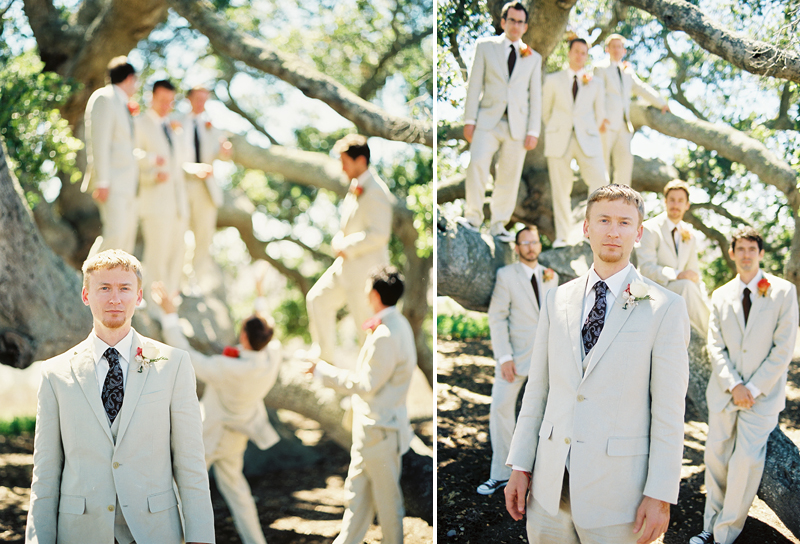 Stop holding your breath and crossing your fingers, because the time has finally come. A brand new film stock, unlike any before, is being released from Kodak! The new Portra400 "Incorporates Entertainment Imaging's KODAK VISION Film Technology" and is "the world’s finest grain high-speed color negative film" according to Eastman Kodak today. You know what this means? Still photographers will finally be able to capture the light that cinematographers have been spoiled with for years. You can see more on Kodaks website, KODAK PROFESSIONAL PORTRA 400 Film
Stop holding your breath and crossing your fingers, because the time has finally come. A brand new film stock, unlike any before, is being released from Kodak! The new Portra400 "Incorporates Entertainment Imaging's KODAK VISION Film Technology" and is "the world’s finest grain high-speed color negative film" according to Eastman Kodak today. You know what this means? Still photographers will finally be able to capture the light that cinematographers have been spoiled with for years. You can see more on Kodaks website, KODAK PROFESSIONAL PORTRA 400 Film
This is the dawn of a whole new line of light sensitive materials. Created for the hybrid workflow, the Vision technology harnesses light like no other emulsion. We have tested it's limits with our Nikon F3 250 exp. film backs, and processing at Technicolor for the past year. I cant tell you how excited I am! Vision in medium and large format! But not until October... So for now, in honor of the release of the new Kodak Portra400, we give you a taste of 35mm Vision technology.
35mm Kodak Vision3 250D up against Fuji PRO400H 6x7cm negative!
This is far from a fair comparison here. A 6x7 negative is 4 times the size of a 35mm frame, and the P67 SMC glass is the best around. I exposed 35mm 250D at ISO 400, and 220 400H at ISO 200. I performed straight scans of each on our Fuji Frontier at an 8x10 proportionate print resolution, then scaled directly to original magnification. You can see for yourself...
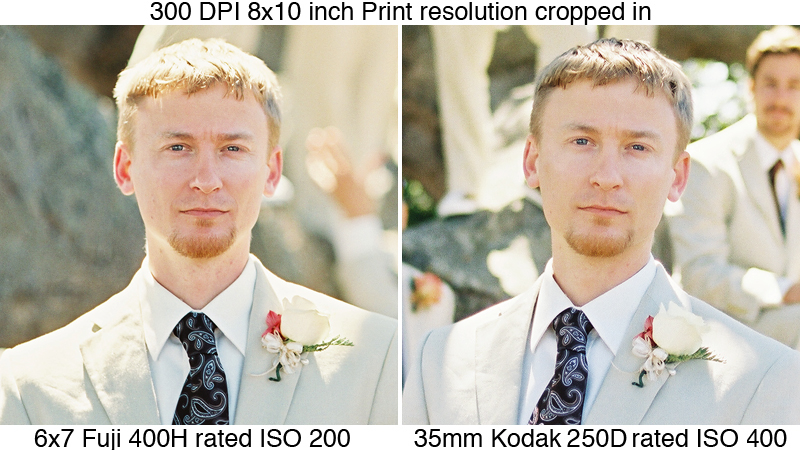
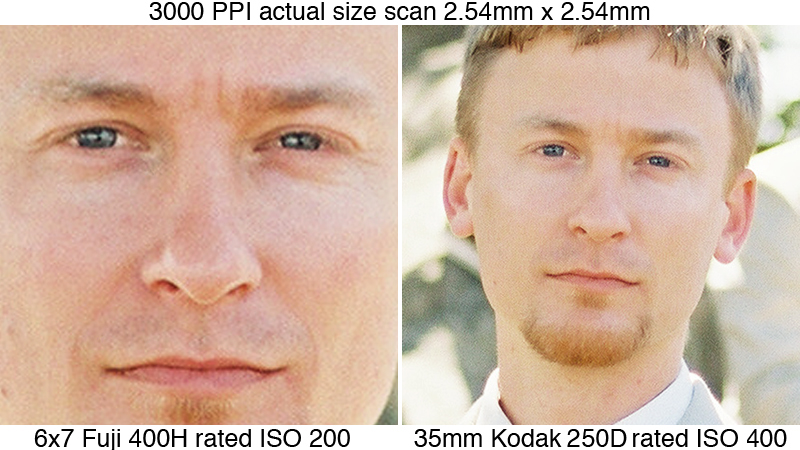
It is a brand new day and film is not dead, it's just entering a new generation. And it's heirs shall have more majesty as splendor than ever! c'mon... Say it with me... LONG LIVE FILM!
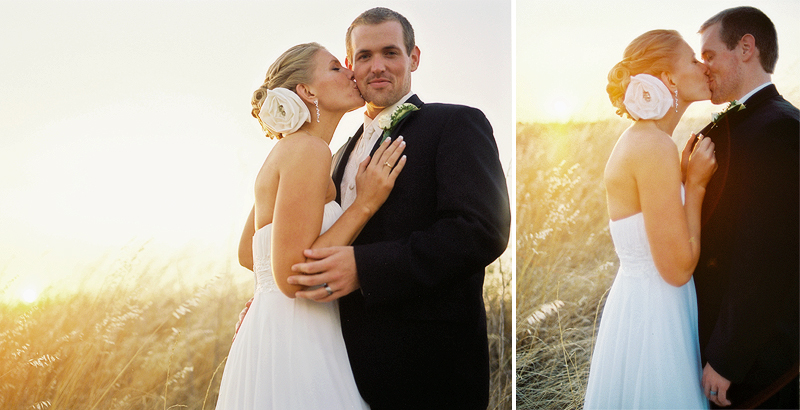 For many artists straining to see in the dark of a digital age, the recent news of Fuji ending production of 400H in 220 can feel like the final blinding blow from the digital demagogues. After seeing Kodachrome, 800Z, and countless other beautiful stocks (not to mention Polaroid) vanish before our eyes, we have clung to the analoged daylight of the past. After all "Photography" breaks down to "the writing (archiving) of light" in greek, and as photographers we cherish moments of light. I recently received an alarmist text from a fresh photographer, choosing to shoot film, reading "Film is dead, Fuji is killing it!" Another such phone call left me with the image of a successful photographer weeping at her desk, after running into "discontinued" notifications online. I have followed up these emotional reactions with reassurance and rationality, but as these occurrences are becoming all too common, I decided offer our foresight to the public.
For many artists straining to see in the dark of a digital age, the recent news of Fuji ending production of 400H in 220 can feel like the final blinding blow from the digital demagogues. After seeing Kodachrome, 800Z, and countless other beautiful stocks (not to mention Polaroid) vanish before our eyes, we have clung to the analoged daylight of the past. After all "Photography" breaks down to "the writing (archiving) of light" in greek, and as photographers we cherish moments of light. I recently received an alarmist text from a fresh photographer, choosing to shoot film, reading "Film is dead, Fuji is killing it!" Another such phone call left me with the image of a successful photographer weeping at her desk, after running into "discontinued" notifications online. I have followed up these emotional reactions with reassurance and rationality, but as these occurrences are becoming all too common, I decided offer our foresight to the public.
The future may seem pretty dark, but to everything there is a time and a season, and you can't make an omelet without cracking a few eggs. And if Fuji's 400h is an exegetical egg, then Kodak's Vision3 is the Goose that's laying the golden egg! But platitudes aside, let me assure you that film is only going to get better! How do I know this? Because I have seen the future, and it's brighter than ever. You see, film is manufactured (and will continue to be for a long time coming) primarily for motion picture films. TV shows and movies pay millions of dollars per production to film manufacturers. So it is in the interest of; say Kodak, to spend all of it's R&D on motion picture stocks. This technology is only handed down to us, still photographers, years later; i.e. Kodak's celebrated Ektar 1oo is based off of a technology used by cinematographers for a decade.
As recently as this June kodak has been releasing the most exciting emulsions in their Vision3 line of film stocks. We have been shooting these ECN2 negative films since January, and working with Technicolor to have our 250 exposure rolls processed. Our journey into the future has been quite amazing! Our first test was high ISO 35mm 500T vs 800z in low light, and the results blew us away. We then followed up with some real world examples, and upped the ante by comparing 500T to 35mm 400H and 800Z in 220! Now I'm going to blow some minds...
We shoot the Vision3 500T film in our 35mm Nikon F3's with bulk backs, and one of our favorite setups for MF is our Pentax 6x7 with Fuji 400H. This is far from a fair comparison here. A 6x7 negative is 4 times the size of a 35mm frame, and the P67 SMC glass is the best around, not to mention 500T's native ISO is 1000 & tungsten balanced! But I figured what the heck... I exposed 35mm 500T at ISO 800, and 220 400H at ISO 200 (both wide angle lenses were shot wide open). I performed straight scans of each on our Fuji Frontier at an 8x10 proportionate print resolution, then scaled directly to original magnification. You can see for yourself...
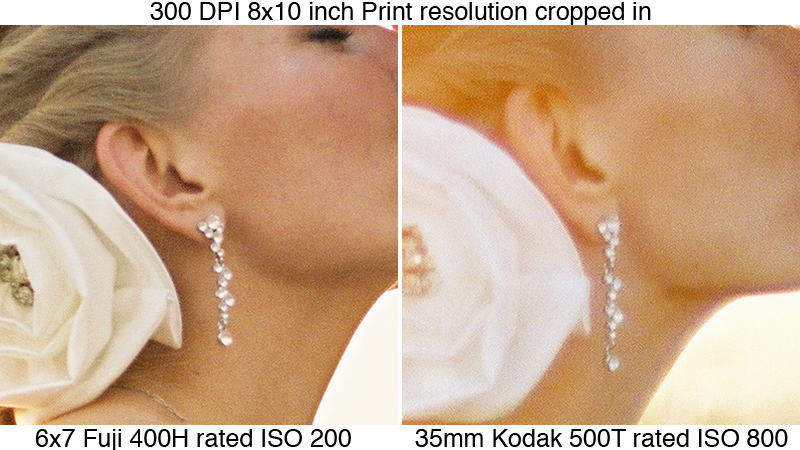
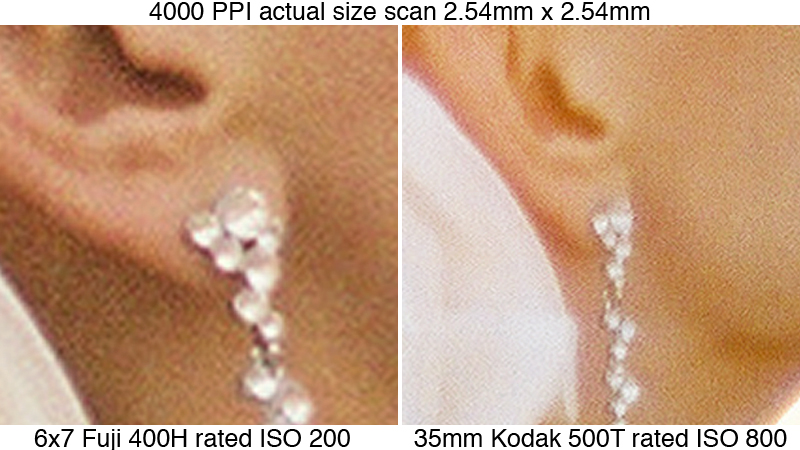
I know that the Pentax glass is superior, and the Nikon is a little softer wide open, but this stuff is ridiculous! Printed at 8x10 neither would have grain visible to naked eye, but the 35mm shot would actually have smoother texture! And just looking at the emulsion close up, I can't help but get excited about what "new" bright ideas Kodak has on the horizon for still photographers... Perhaps in medium format? :-)
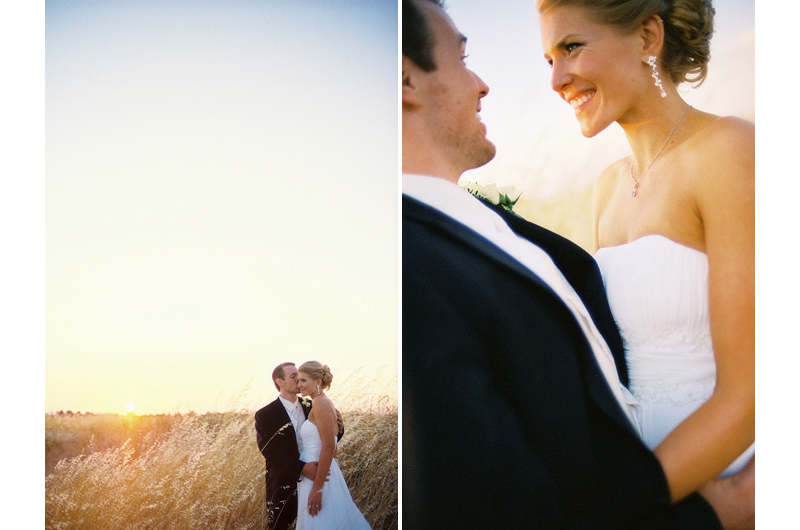

 Canonet QL17 f/1.7 Fuji 400H
Canonet QL17 f/1.7 Fuji 400H
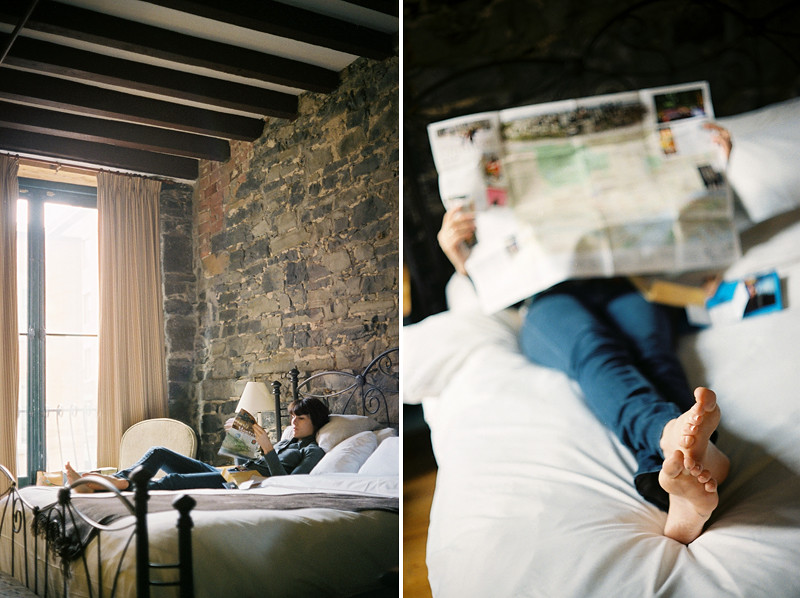 Canonet QL17 40MM f/1.7Fuji 400H
Canonet QL17 40MM f/1.7Fuji 400H
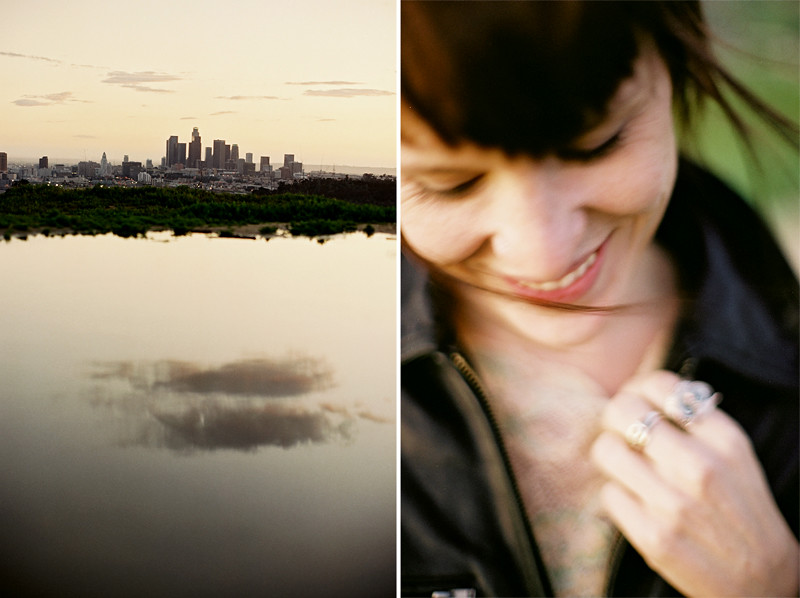 Nikon FE2Nikkor 50mm f/1.2 AIS Fuji 400H
Nikon FE2Nikkor 50mm f/1.2 AIS Fuji 400H
Within the last year digital has made great leaps in high ISO capabilities. But unbeknownst to the world outside of hollywood, film has been making it's own advances well into it's supposed afterlife. This is part 2 of our Kodak Vision 3 500T motion picture film test. For part 1 we set up a controlled study, which can be viewed here. This time we brought our Nikon F3 with 250 exposure MF-4 back to a wedding. Most of the day was to be very low light photojournalistic coverage of a traditional Jewish wedding (full real wedding post coming very soon!). We shot the 500t along side our Nikon FE-2's, range finders, and TLR's and the results are amazing! We had the ECN-2 film processed by Technicolor here in Hollywood, and I scanned all of these samples on our Fuji Frontier with no post-correction in the computer. This is the honest truth!
First off, during preparations we shot some 400h in the lobby of the hotel. We usually overexpose our 400h by a stop. But the 500T? no need. One under is just fine!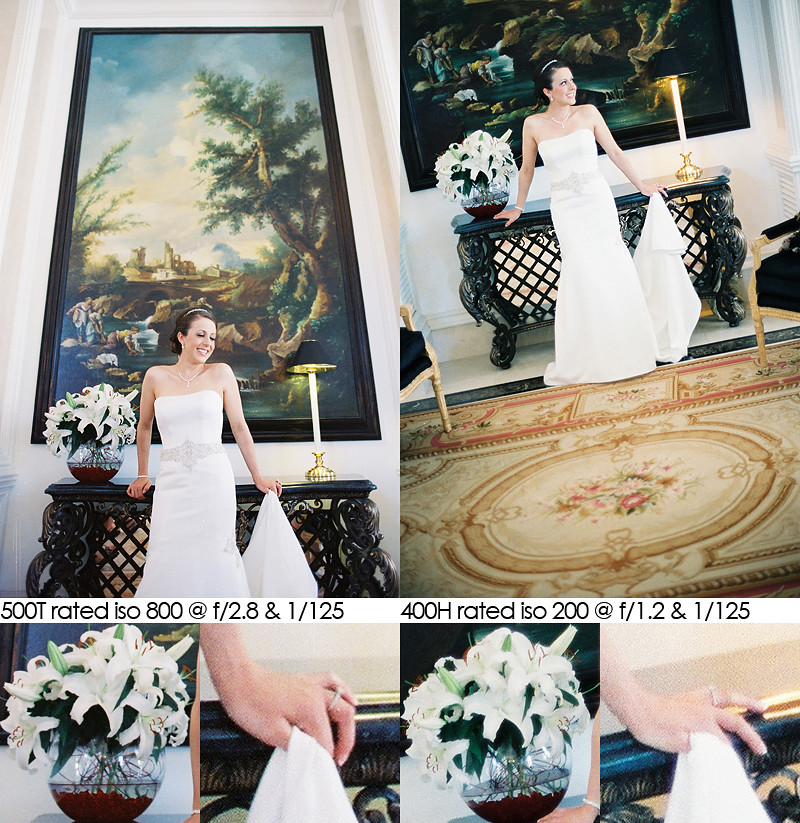
The 500T in 35mm holds up against medium format, could you image 500T220? The exposure difference under the altar was 3 stops and change. Look at that DR!
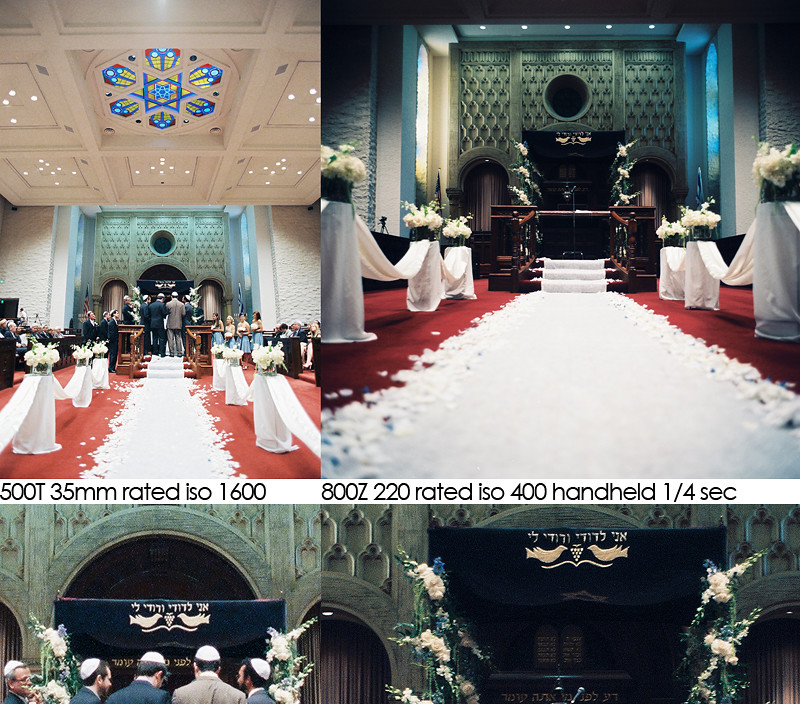
This bulk back came in super handy through all the events leading up to the ceremony in this low lit temple.
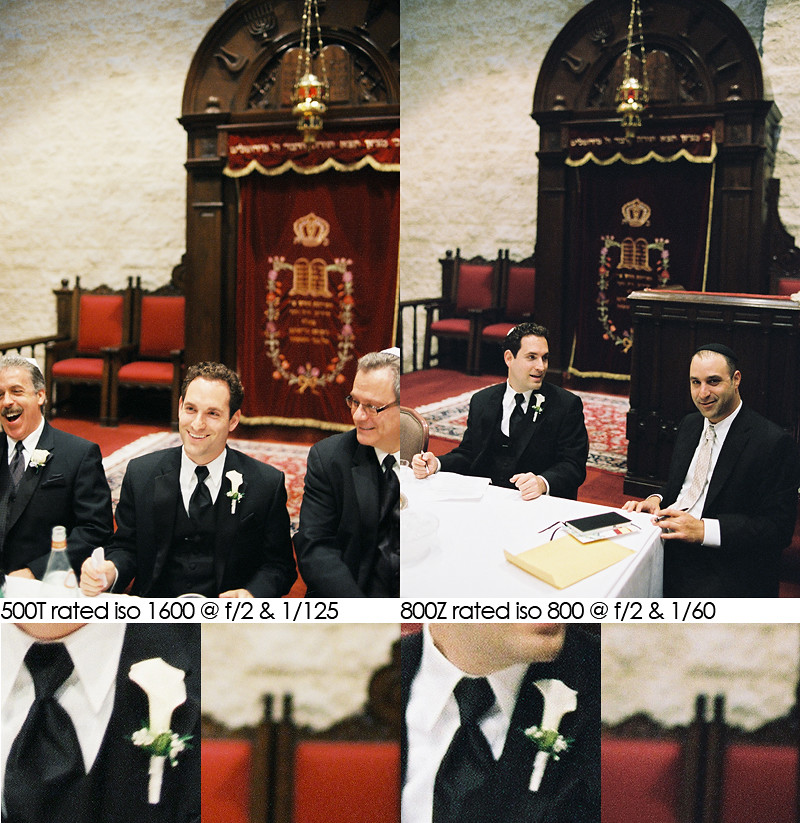
This shot was taken during the day with window light metered off of the table.
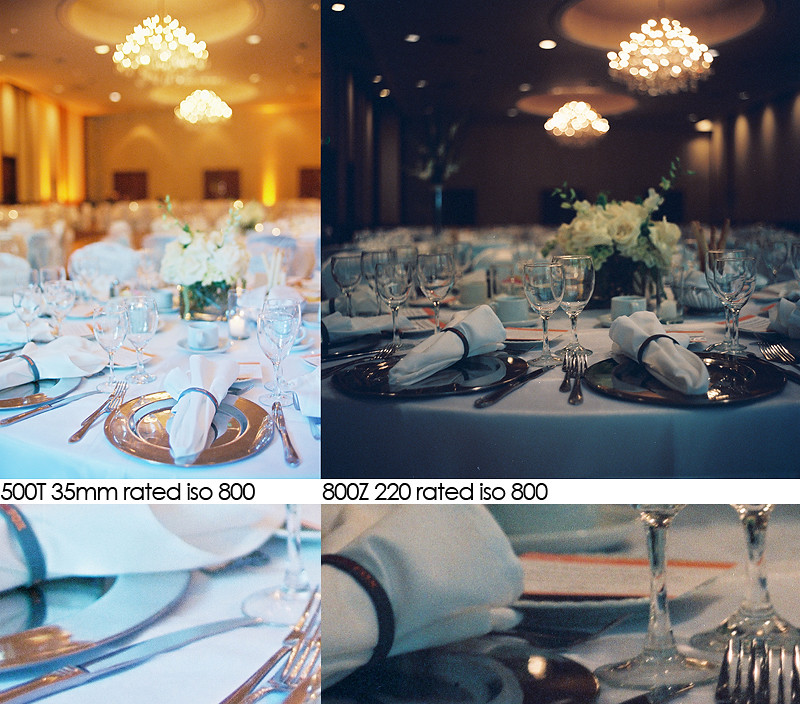
The most amazing thing is the versatility of this film. All temperatures of light and extreme under and over exposure produces acceptable images. But 800z does have a look all it's own.
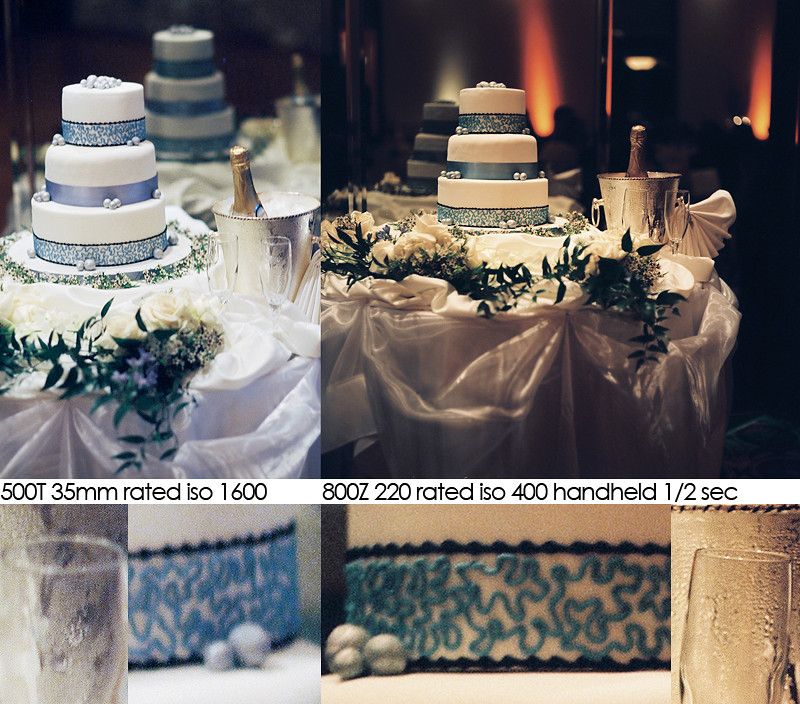
Color images in low light are possible on film! That's the cinematographer's dirty little secret...
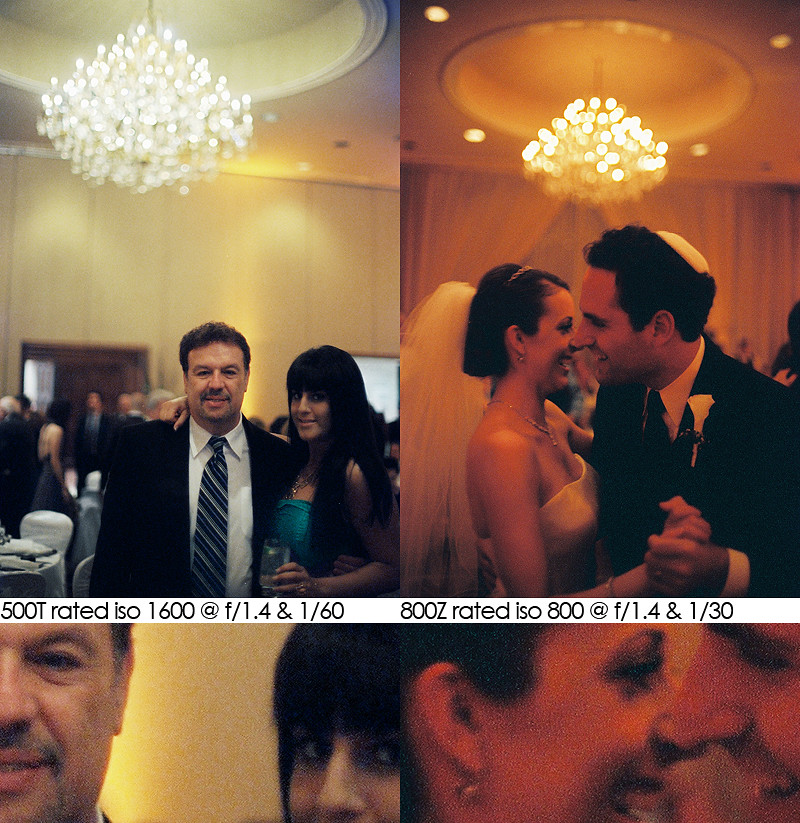
This just demonstrates the advances and potential in film, that are kept just out of arms reach, since the popularization of the "film is dead" ideology, when in fact film is still just maturing! Digital would have a hard time getting these kind of images straight out of the camera, or even through RAW processing. I don't even care if I could achieve it through the right combination of money+time, I still love film! :-)

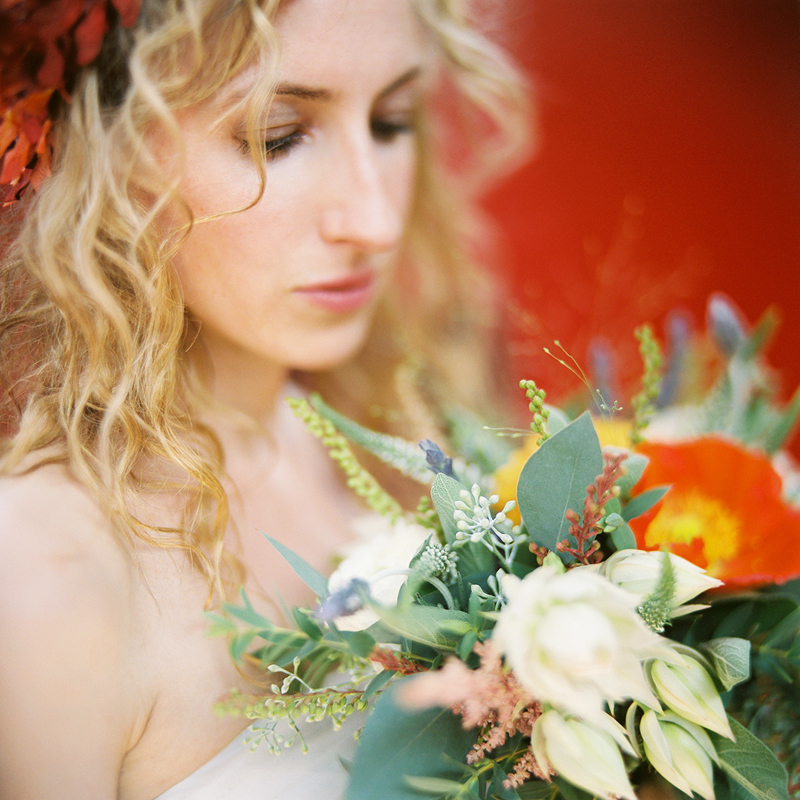

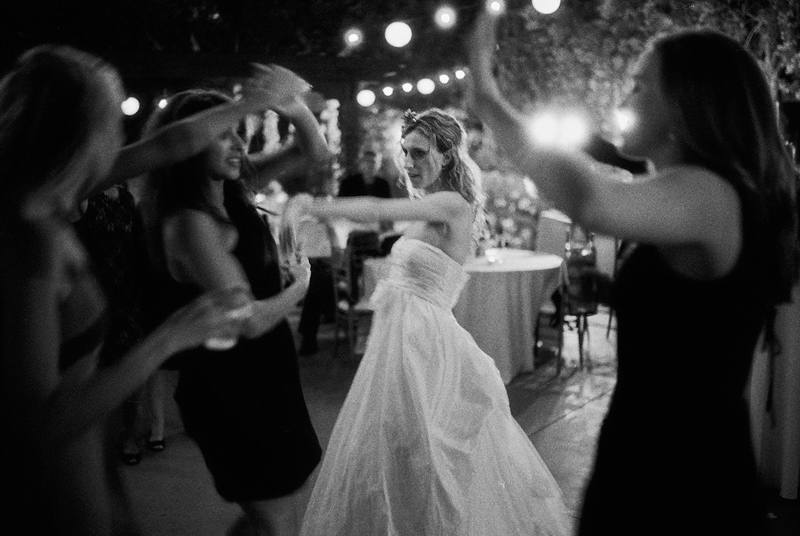

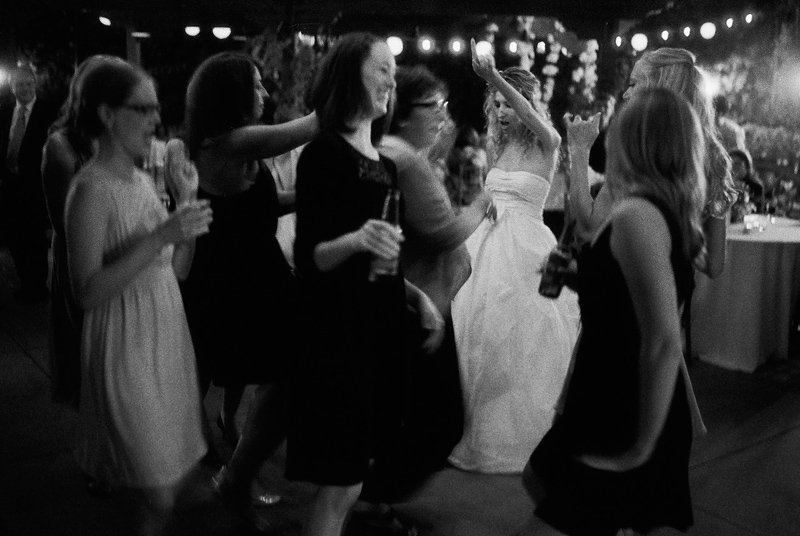
 Welcome to the golden hour of film! The age old tradition of film photography has always possessed an inherent warmth and beauty, that transcends technical explanation. As photographers, we relish something called "The Golden Hour" (sometimes known as magic hour) which is the first and last hour of sunlight during the day, because the quality of light is such that everything becomes magically photogenic. Due to the diffusion of the sun's abundance of light, and the hues created by the atmosphere, everything is illuminated within photographic reach. Well, Kodak's new Portra400 has this magical quality packed right into the emulsion! No matter the lighting situation, Kodak's Vision Technology brings it within reach. Pretty much anything your eye can see now is visible within one frame. We have always loved film for this quality, but the limits have been stretched further than formerly possible.
Welcome to the golden hour of film! The age old tradition of film photography has always possessed an inherent warmth and beauty, that transcends technical explanation. As photographers, we relish something called "The Golden Hour" (sometimes known as magic hour) which is the first and last hour of sunlight during the day, because the quality of light is such that everything becomes magically photogenic. Due to the diffusion of the sun's abundance of light, and the hues created by the atmosphere, everything is illuminated within photographic reach. Well, Kodak's new Portra400 has this magical quality packed right into the emulsion! No matter the lighting situation, Kodak's Vision Technology brings it within reach. Pretty much anything your eye can see now is visible within one frame. We have always loved film for this quality, but the limits have been stretched further than formerly possible. The results don't blow me away with this first shot. It's a suitable replacement for 400h for sure, and that's the main concern really. But when I went in and scanned it way too large, I found amazing resolution, and the beautiful grain that was rumored. It's much smoother and sharper than the old emulsions, once you begin to print above 16x20 at least. ;-)
The results don't blow me away with this first shot. It's a suitable replacement for 400h for sure, and that's the main concern really. But when I went in and scanned it way too large, I found amazing resolution, and the beautiful grain that was rumored. It's much smoother and sharper than the old emulsions, once you begin to print above 16x20 at least. ;-) I knew that the Fuji could take it, but I was pleasantly surprised to find that the Portra actually held up much better. These are all straight scans (untouched) from our Frontier by the way. The Portra doesn't get as muddy in the highlights and has much cleaner color. But again, comforting but not mind blowing.
I knew that the Fuji could take it, but I was pleasantly surprised to find that the Portra actually held up much better. These are all straight scans (untouched) from our Frontier by the way. The Portra doesn't get as muddy in the highlights and has much cleaner color. But again, comforting but not mind blowing. Normally, I wouldn't shoot color film in this ugly of light. Maybe 3200 Delta if I can get away with it. I did not push process this film, even though I underexposed the highlights up to 5 stops. Fuji begins to look horrible at 1 stop under, but the Portra looks exponentially better in comparison each stop under! At 12,000 ISO the fuji begins to even loose the detail in the light bulbs, but the new Portra 400 keeps some shadow detail up to 6400 ISO! To give you an idea, a guy with a 5D was having trouble getting their faces without loosing the sign at 6400. I will probably never underexpose film again, but I will most definitely push this Golden film to 3200.
Normally, I wouldn't shoot color film in this ugly of light. Maybe 3200 Delta if I can get away with it. I did not push process this film, even though I underexposed the highlights up to 5 stops. Fuji begins to look horrible at 1 stop under, but the Portra looks exponentially better in comparison each stop under! At 12,000 ISO the fuji begins to even loose the detail in the light bulbs, but the new Portra 400 keeps some shadow detail up to 6400 ISO! To give you an idea, a guy with a 5D was having trouble getting their faces without loosing the sign at 6400. I will probably never underexpose film again, but I will most definitely push this Golden film to 3200. "It's our favorite time of light, just before the day kisses the night. You see the red winged blackbirds fly. The sun's a big ol' lazy eye. When the day is bending low, and rolling fields begin to glow, feels like we traveled all this way, just so I could hear you say, It's our favorite time of light... It's our favorite time of light, just before the day kisses the night. You see the red winged blackbirds fly. The sun's a big ol' lazy eye. The moon is waiting in the wings, dreaming up some midnight song to sing, and I know we'll be okay evry time I hear you say, it's our favorite time of light." - Over The Rhine
"It's our favorite time of light, just before the day kisses the night. You see the red winged blackbirds fly. The sun's a big ol' lazy eye. When the day is bending low, and rolling fields begin to glow, feels like we traveled all this way, just so I could hear you say, It's our favorite time of light... It's our favorite time of light, just before the day kisses the night. You see the red winged blackbirds fly. The sun's a big ol' lazy eye. The moon is waiting in the wings, dreaming up some midnight song to sing, and I know we'll be okay evry time I hear you say, it's our favorite time of light." - Over The Rhine Stop holding your breath and crossing your fingers, because the time has finally come. A brand new film stock, unlike any before, is being released from Kodak! The new Portra400 "Incorporates Entertainment Imaging's KODAK VISION Film Technology" and is "the world’s finest grain high-speed color negative film" according to Eastman Kodak today. You know what this means? Still photographers will finally be able to capture the light that cinematographers have been spoiled with for years. You can see more on Kodaks website, KODAK PROFESSIONAL PORTRA 400 Film
Stop holding your breath and crossing your fingers, because the time has finally come. A brand new film stock, unlike any before, is being released from Kodak! The new Portra400 "Incorporates Entertainment Imaging's KODAK VISION Film Technology" and is "the world’s finest grain high-speed color negative film" according to Eastman Kodak today. You know what this means? Still photographers will finally be able to capture the light that cinematographers have been spoiled with for years. You can see more on Kodaks website, KODAK PROFESSIONAL PORTRA 400 Film

 For many artists straining to see in the dark of a digital age, the recent news of Fuji ending production of 400H in 220 can feel like the final blinding blow from the digital demagogues. After seeing Kodachrome, 800Z, and countless other beautiful stocks (not to mention Polaroid) vanish before our eyes, we have clung to the analoged daylight of the past. After all "Photography" breaks down to "the writing (archiving) of light" in greek, and as photographers we cherish moments of light. I recently received an alarmist text from a fresh photographer, choosing to shoot film, reading "Film is dead, Fuji is killing it!" Another such phone call left me with the image of a successful photographer weeping at her desk, after running into "discontinued" notifications online. I have followed up these emotional reactions with reassurance and rationality, but as these occurrences are becoming all too common, I decided offer our foresight to the public.
For many artists straining to see in the dark of a digital age, the recent news of Fuji ending production of 400H in 220 can feel like the final blinding blow from the digital demagogues. After seeing Kodachrome, 800Z, and countless other beautiful stocks (not to mention Polaroid) vanish before our eyes, we have clung to the analoged daylight of the past. After all "Photography" breaks down to "the writing (archiving) of light" in greek, and as photographers we cherish moments of light. I recently received an alarmist text from a fresh photographer, choosing to shoot film, reading "Film is dead, Fuji is killing it!" Another such phone call left me with the image of a successful photographer weeping at her desk, after running into "discontinued" notifications online. I have followed up these emotional reactions with reassurance and rationality, but as these occurrences are becoming all too common, I decided offer our foresight to the public.








